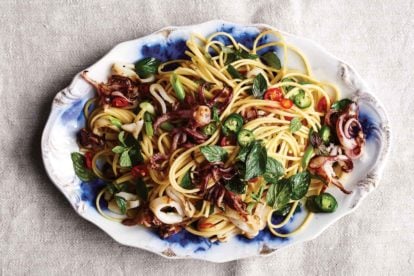Learn To Make Low FODMAP Chicken Thighs with Lemon & Oregano
Let’s get this out right away – this recipe is ALL about technique. You will be putting the chicken in a COLD pan. That’s right; that’s not a mistake. And you will be rewarded with shatteringly crispy skin.
Just look at the picture of our Low FODMAP Chicken Thighs with Lemon & Oregano. You want to take a bite, don’t you?

I found this recipe at my alma mater, the Bon Appetit Test Kitchen. Their version used a fair amount of garlic, which we have eliminated, subbing in Garlic-Infused Oil, made with olive oil. The original call for shallot is put aside for low FODMAP scallion greens.
I also decided I liked this dish without the red pepper flakes, allowing the lemon and oregano to truly shine.
You have to use fresh oregano for this dish, so don’t skimp!
Dark Meat Is The Perfect Choice
We love chicken thighs because we find the dark meat to be reliably juicy, but on occasion we are faced with flabby skin. Flabby skin is not acceptable anywhere. This recipe takes care of that issue.
Skin Down, Thumbs Up
By starting the chicken skin side down, in a cold pan over medium heat, the fat in the skin slowly renders and the chicken thighs begin to cook in their own hot fat, becoming super duper crispy.
It is a brilliant technique and we bet you will use it again and again with your own low FODMAP seasonings.
For another top-of-the-stove chicken dish, check out our Low FODMAP Braised Chicken & Mushroom Ragu.

FODMAP IT!™ Chicken Thighs with Lemon & Oregano
Before you think "one-more-boring-chicken-recipe" let me assure you that our cold pan technique is going to make you re-think chicken dinner.
Ingredients:
- 6 skin-on bone-in chicken thighs (about 2 pounds/910 g)
- Kosher salt
- Freshly ground black pepper
- 1 lemon
- 1 tablespoon Garlic-Infused Oil, made with olive oil, or purchased equivalent, divided
- 2 tablespoons finely minced scallions, green parts only
- Sprigs of fresh oregano
- 1/3 cup (75 ml) low FODMAP chicken stock
- 1/3 cup (75 ml) dry white wine
Preparation:
-
Position rack in middle of oven. Preheat oven to 450°F/230°C.
-
Season the chicken thighs on all sides generously with salt and pepper. Thinly slice half of the lemon, discarding any seeds. Cut the remaining lemon into wedges, also discarding any seeds.
-
Coat the bottom of a cold skillet with 1 teaspoon of the oil and place the chicken thighs, skin side down in the pan. Turn heat to low-medium and cook the chicken slowly, allowing the chicken fat to render. The chicken will be cooking in its own fat; pour off any excess, if necessary to keep just a nice, thin, even coating of fat in the pan. Keep cooking until skin is crispy, about 10 minutes.
-
Tuck some of the sliced lemons under the thighs and place the remaining slices on top - at least one slice of lemon on each thigh, still skin side down. Place pan in oven and roast until chicken in cooked through, about 8 minutes.
-
Transfer chicken to a warm platter with most of the lemon pieces; leave a few in the pan. Cover chicken loosely with aluminum foil.
-
Return pan to the stovetop. Add remaining 2 teaspoons of oil along with the scallion greens and a sprig of oregano and sauté over medium heat until scallions soften.
-
Add the chicken stock and wine, turn heat up and cook until liquid is reduced by about half and is visibly thickened. Squeeze the lemon wedges over the sauce, taste, and adjust salt and pepper seasoning. Add chicken back to pan, skin-side up with lemon slices on each thigh, and cook for a few minutes to heat through. Serve with lemon slices and garnish with fresh oregano. We will this dish with rice.
Notes:
Tips
- This cold pan technique was a revelation to us and we think you will LOVE it. You can apply it to your own stovetop chicken recipes. It works best with thighs, but you can try other chicken parts.
Nutrition
All nutritional information is based on third-party calculations and should be considered estimates. Actual nutritional content will vary with brands used, measuring methods, portion sizes and more. For a more detailed explanation, please read our article Understanding The Nutrition Panel Within Our Recipes.







